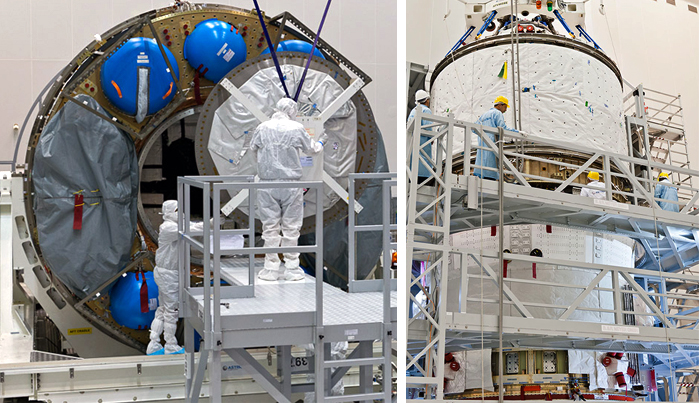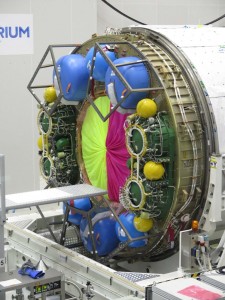Each ATV carries several types of cargo in varying amounts; the figures below are for ATV-5, whose total cargo upload to the ISS will be 6,561 kg. Thanks to Charlotte Beskow and the ATV team at ESA for these details!

After completion of its initial cargo loading process in the Spaceport’s S5C facility, the ATV Integrated Cargo Carrier’s large aft opening is sealed (photo at left). This element was then mated with the Service Module to form the completed Automated Transfer Vehicle (at right). Image taken earlier in May. Credit: ESA/CNES/Arianespace – Photo Optique Video du CSG
Propellant for use by ATV when attached to ISS: 2118 kg
The ATV thrusters can be commanded from the Russian segment to provide thrust to maintain the ISS orbit (i.e. perform reboosts) and to set up / adjust the ISS attitude for incoming & departing vehicles.
ATV is also used to perform collision avoidance manoeuvres. This is needed in case the space debris specialists on ground identify objects whose estimated trajectories come too close to that of ISS. Considering the amount of debris surrounding the Earth, such manoeuvres can occur several times during any particular ATV mission.
Propellant for ISS: 860 kg
The Russian segment can perform reboost and attitude-control manoeuvres using engines on the Russian Service Module (SM). It can do so provided there is no vehicle attached to its aft port (i.e. the port where ATV and Progress vessels usually dock). This is necessary in the event that manoeuvres need to be performed when ATV/Progress are not present.
Therefore, the fuel reserve for the SM needs to be replenished. ATV carries a separate set of fuel tanks (fuel and oxidiser) and 860 kg for the Russian segment. This fuel is transferred via an automatic process, managed from MCC-M in Moscow, during the attached phase.
Russian water for ISS crew: 855 kg
ATV is equipped with 3 tanks that can carry water. For the first time, all 3 tanks are loaded. As in previous flights, we are carrying Russian water. The difference between Russian and American water is that Russian water uses silver as the biocide, whereas American water uses iodine. The Russian water comes from Italy. Three water tanks are hidden behind the big blue covers. The three gas tanks are hidden behind the small blue covers
Air and Oxygen: 100 kg in total
ATV will also carry 100 kg of gas. What we carry (air, oxygen, nitrogen) is defined by NASA two months before launch in order to optimise the cargo with respect to what is needed on board. ATV-5 will most likely be carrying 33 kg breathable Air and 67 kg Oxygen.
Dry cargo: 2,528 kg
ATV carries dry cargo in special cargo transfer bags which are strapped onto the shelves inside the pressurised module. As usual, the dry cargo will contain clothing, crew items, some spare parts and some specific equipment for ISS.
If we include the cargo accommodation hardware (racks, plates, etc.), this amounts to 4,066 kg. The cargo bags can be seen behind the disinfection team members; see the white bags strapped into place by black belts
The cargo-carrying half of ATV (the ICC) was closed on 30 April and the two parts of ATV are now mated.



 Automated Transfer Vehicle page
Automated Transfer Vehicle page ATV blog archive
ATV blog archive
Discussion: no comments